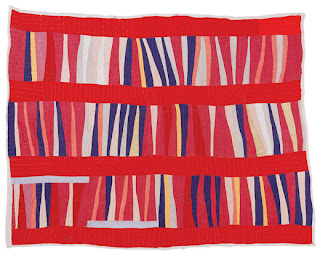The Quilting Women of Gee's Bend
Posted by
Carol Ng-He
I am not a quilter but something about quilting always captivates me. The patches of
fabrics of various patterns and colors, the handmade stitches, the “imperfect”
lines and shapes. In the culture where I was brought up, traditional Chinese
quilts are often used as a gift for newborns; friends and family are invited
to contribute a patch of cloth with a wish for the baby. They are called Bai
Jia Bei (in
translation "One Hundred Good Wishes Quil"t). The quilts contains symbols of luck, energy, and good wishes. They are to be passed down
from generation to generation, just like those in America.
One
particular kind of quilt that goes beyond passing the tradition is the one
made by the women of Gee’s Bend, Alabama. What strikes me about their quilts are their
artistic execution and the background story that gives rise to this unique
style. They are women with passion, struggle and solidarity--attributes that imbue their quilts, too.
 |
| Jessie T. Pettway, Untitled, c. 1950. Collection of the Tinwood Alliance. Image Credit: Smithsonian Magazine. |
Gee’s Bend
women lived in a small rural plantation community located in southwest Alabama. It is
virtually an island, surrounded by a bend in the Alabama River. Named after
Joseph Gee, the first white man to claim the land in early 19th
century, this plantation was later sold to Mark Pettway in 1845. The Gee’s Bend
residents who were descendants of the former Pettway plantation slaves remained in the area to live and work on the land after emancipation. In the 1940s, the residents eventually purchased the land from
the government. During the Civil Rights Movement in the 1960s, Gee’s Band people
lost their jobs and homes, and the ferry service that shuttled them to the outside world was shut down.
Isolated
geographically and experiencing poverty, the women of Gee’s Bend showed an
enormous level of passion and persistence in creating these quilts, even with extremely limited materials. From the sophisticated visual composition of color, pattern,
geometric shapes and layering, I see the power to transform ordinary
to extraordinary, and turn a necessity into a beautiful work of art.
 |
| Loretta Pettway, Untitled, 1960. Collection of the Tinwood Alliance. Image Credit: Smithsonian Magazine. |
Last August, I had the opportunity to visit the exhibition – Creation Story: Gee’s Bend Quilts and the Art of Thornton Dial at the Frist Center for the Visual Arts in Nashville, Tennessee. I stood in front of the quilts in awe, feeling the presence of the Gee’s Bend women fighting against daily adversity and social oppression by making art together. I felt utterly empowered walking out from the exhibition. Gee’s Bend quilters use old clothing to make connection with other people and their own cultural heritage. One of the quilters, Louisiana P. Bendolph (born in 1960) considers her quilts to be an expression of her life experiences:
“There were three generations ahead of me making quilts, and we would sit and play under the quilts and would watch the needle going in and out of the fabric…This whole thing (quilting) has made feel such a strong connection back to my family. Part of me feels like I’m living in a dream and I’m going to wake up.” (Creation Story, 2012).
Reference:
Creation
Story: Gee’s Bend Quilts and the Art of Thornton Dial (2012). Nashville, TN: Vanderbilt
University Press.
